Return to Naval Historical
Center home page.  Return to Online
Library listing
Return to Online
Library listing
DEPARTMENT OF THE NAVY -- NAVAL HISTORICAL CENTER
805 KIDDER BREESE SE -- WASHINGTON NAVY YARD
WASHINGTON DC 20374-5060

Online Library of Selected Images:
-- PEOPLE -- UNITED STATES --
Lieutenant Commander Edouard V.M. Isaacs, USN (Retired), 1891-1990
Later: Representative Edouard V.M. Izac, M.C.
Edouard Victor Michel Isaacs was born in Cresco, Iowa, on 18
December 1891. He attended High School at South St. Paul, Minnesota,
and in May 1911 was appointed to the U.S. Naval Academy from the
State of Illinois. After graduating with the class of 1915, Ensign
Isaacs served in the battleships Kansas
and Florida.
In mid-1917 he was assigned to USS President
Lincoln, a former German passenger liner then fitting
out as a troop transport. During that year he received temporary
promotions to the ranks of Lieutenant (Junior Grade) and Lieutenant,
with these becoming permanent in 1918 and 1920, respectively.
When the President Lincoln was torpedoed and sunk by
the German Submarine U-90 on 31 May 1918, Lieutenant Isaacs
was captured and taken to Germany. During this trip he gathered
information on enemy submarine operations that he believed would
be of great value to the Allied war effort. Determined to get
this into U.S. Navy hands at the earliest opportunity, he made
several fruitless attempts to escape, one while the U-90
was passing near Denmark and Sweden, one while imprisoned at Karlsruhe
in early July 1918 and another shortly afterwards, when he hurled
himself through the window of a moving train car while en route
from Karlsruhe to a prisoner of war facility at Villingen. Injured
in the latter attempt, he was quickly recaptured, badly beaten
and spent nearly three weeks in solitary confinement.
During more than two months at Villingen, Isaacs gradually
regained his strength while actively pursuing his escape intentions.
With several other officers, he broke free on night of 6-7 October
1918. Accompanied by sub-lieutenant Willis, another American who
had been captured while serving with the French air force, he
walked a long, cautious route to the border, mainly subsisting
on raw vegetables en route. Following a difficult swim across
the swiftly-flowing Rhine River, both men safely reached neutral
Switzerland in the early hours of 13 October. Several days later
Lieutenant Isaacs arrived in Paris and from there went on to London,
where he provided his German submarine information to U.S. and
British Navy authorities. He then returned to the United States,
arriving in Washington, D.C., on 11 November 1918, the day the
Armistice brought World War I's active combat to an end.
In 1919 Isaacs produced a small book, "Prisoner of the
U-90", recounting his experiences, which were recognized
by the award of the Medal
of Honor. He remained in active Navy service, mainly at the
Naval Gun Factory
in Washington, D.C., until retired for disability in May 1921.
While making his home in San Diego, California, he changed his
family name to Izac in July 1925 and pursued a career as a journalist
and writer. During the later 1920s and early 1930s, he lived in
Paris, France, and in January 1936 received promotion to Lieutenant
Commander on the retired list. In November of that year Izac was
elected to Congress from San Diego. He was a member of the House
of Representatives for ten years and remained a resident of the
Washington, D.C., area for the rest of his long life. Edouard
V.M. Izac died in Fairfax, Virginia, on 17 January 1990.
This page features all the views we have concerning Lieutenant
Commander Edouard V.M. Isaacs, who was later Congressman Edouard
V.M. Izac.
Click on the small photograph to prompt
a larger view of the same image.
Photo #: NH 48836
Lieutenant Edouard Victor Michel Isaacs, USN
World War I era portrait photograph, taken by Harris & Ewing,
Washington, D.C..
Lieutenant Isaacs was awarded the Medal of Honor for his heroism
as a prisoner of war after USS President Lincoln was sunk
on 31 May 1918.
He changed his name to Edouard V. M. Izac in July 1925.
U.S. Naval Historical Center Photograph.
Online Image: 45KB; 505 x 765 pixels |
 |
Photo #: NH 103348
Lieutenant Edouard Victor Michel Isaacs, USN
Halftone reproduction of a photograph, published in "Medal
of Honor, 1861-1945, The Navy", page 118.
Lieutenant Isaacs was awarded the Medal of Honor for heroic conduct
as a prisoner of war following the sinking of USS President
Lincoln on 31 May 1918.
He changed his family name from Isaacs to Isac in 1925.
U.S. Naval Historical Center Photograph.
Online Image: 68KB; 630 x 765 pixels |
 |
Photo #: NH 103362
Lieutenant (Junior Grade) Edouard V.M. Isaacs, USN
On board USS President Lincoln, circa mid-1917.
The original image was printed on postal card ("AZO")
stock.
Courtesy of the Naval Historical Foundation, Washington, D.C.
- USS President Lincoln Collection.
U.S. Naval Historical Center Photograph.
Online Image: 46KB; 420 x 765 pixels |
 |
Photo #: NH 103271
USS President Lincoln (1917-1918)
Ship's Junior Officers posed on board, in early May 1918.
The Lieutenant at the left end of the middle row is Edouard V.M.
Isaacs, who was made a prisoner of war when President Lincoln
was sunk on 31 May 1918.
Courtesy of the Naval Historical Foundation, Washington, D.C.
- USS President Lincoln Collection.
U.S. Naval Historical Center Photograph.
Online Image: 69KB; 740 x 465 pixels |
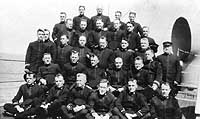 |
Photo #: NH 2172
Lieutenant Edouard V. M. Isaacs, USN
(seated, right, in dark uniform)
With "U.S. Army officers imprisoned at Karlsruhe",
Germany, probably in early July 1918.
Lt. Isaacs was captured on 31 May 1918 by the German submarine
U-90 when USS President Lincoln was sunk. "After
three weeks at Karlsruhe he was sent to Villingen. On the way
he jumped from a train going 40 miles an hour. He was recaptured
and given two weeks in the solitary. On the night of October
6 he, with the help of other officers, short-circuited all lighting
circuits and escaped under heavy rifle fire. He arrived in Washington,
D.C., four weeks later."
Fine screen halftone reproduction, printed in a World War I era
publication.
Lieutenant Isaacs was awarded the Medal of Honor for his exploits.
Note: Quoted passages are taken from the text printed
with the original image.
U.S. Naval Historical Center Photograph.
Online Image: 98KB; 615 x 765 pixels |
 |
Photo #: NH 103351
Lieutenant Edouard V.M. Isaacs, USN (right)
Halftone reproduction of a photograph, published opposite page
130 of his 1919 book "Prisoner of the U-90".
The view appears to have been taken while he was held at the
Villingen, Germany, prisoner of war camp, circa July-October
1918.
Courtesy of the Navy Department Library, Washington, D.C.
U.S. Naval Historical Center Photograph.
Online Image: 57KB; 440 x 765 pixels |
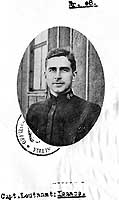 |
Photo #: NH 103350
Lieutenant Edouard V.M. Isaacs, USN (right)
Halftone reproduction of a photograph, published as the frontispiece
of his 1919 book "Prisoner of the U-90".
The view shows Lt. Isaacs at the Villingen, Germany, prisoner
of war camp with other members of his mess, circa late July or
early August 1918. He had sent the photograph to his home on
13 August. Also present are two British officers, Jeffrey and
Hardesty, and sub-lieutenant Willis, an American who had been
captured circa mid-1917, while serving with the French air force's
Lafayette Escadrille. Willis and Isaacs escaped from Villingen
in October 1918 and together made their way to Switzerland.
Courtesy of the Navy Department Library, Washington, D.C.
U.S. Naval Historical Center Photograph.
Online Image: 89KB; 440 x 765 pixels |
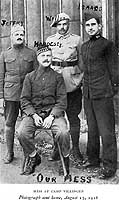 |
Photo #: NH 58053
Fleet Admiral Chester W. Nimitz, USN,
Commander in Chief, Pacific Fleet and Pacific Ocean Areas, (standing,
4th from left)
With a party of visiting Congressmen, at Guam on 18 July 1945.
Those present include (kneeling, left to right):
Representative Cecil W. Bishop (Illinois); and
Representative Herbert C. Bonner (North Carolina).
(standing, left to right)
Representative Andrew J. Biemiller (Wisconsin);
Representative Albert A. Gore (Tennessee);
Representative Edouard V.M. Izac (California);
Fleet Admiral Nimitz;
Representative Henry M. Jackson (Washington);
Representative Ellis E. Patterson (California);
Delegate Joseph R. Farrington (Territory of Hawaii); and
Major General Henry L. Larsen, USMC, Island Commander on Guam.
The aircraft in the background is a R5D/C-54 type.
Collection of Fleet Admiral Chester W. Nimitz.
U.S. Naval Historical Center Photograph.
Online Image: 89KB; 740 x 535 pixels |
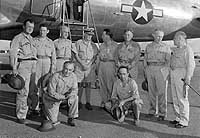 |
Photo #: NH 82602
The Medal of Honor
Reverse of a "Tiffany Cross" pattern Medal of Honor
awarded to Lieutenant Edouard V.M. Izaacs (Izac) for heroism
following the sinking of USS President Lincoln on 31 May
1918.
U.S. Naval Historical Center Photograph.
Online Image: 97KB; 585 x 765 pixels |
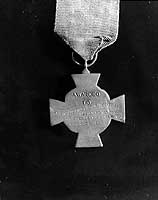 |
Medal of Honor citation of Lieutenant Edouard Victor Michel
Izac (Isaacs) (as printed in the official publication "Medal
of Honor, 1861-1949, The Navy", page 118):
"When the U.S.S. President Lincoln was attacked
and sunk by the German submarine U-90 on 21 May (sic
-- actually 31 May) 1918, Lieutenant Izac (sic -- then:
Issacs) was captured and held as a prisoner on board the
U-90 until the return of the submarine to Germany, when
he was confined in the prison camp. During his stay on the U-90
he obtained information on the movements of German submarines
which was so important that he determined to escape, with a view
to making this information available to the United States and
Allied naval authorities. In attempting to carry out this plan,
he jumped through the window of a rapidly moving train at the
imminent risk of death, not only from the nature of the act itself
but from the fire of the armed German soldiers who were guarding
him. Having been recaptured and reconfined, Lieutenant Izac made
a second and successful attempt to escape, breaking his way through
barbed-wire fences and deliberately drawing the fire of the armed
guards in the hope of permitting others to escape during the
confusion. He made his way through the mountains of southwestern
Germany, having only raw vegetables for food, and at the end,
swam the River Rhine during the night in the immediate vicinity
of German sentries." |
 Return to Naval
Historical Center home page.
Return to Naval
Historical Center home page.
Page made 30 November 2005
New images added and caption corrected 28 December 2005
